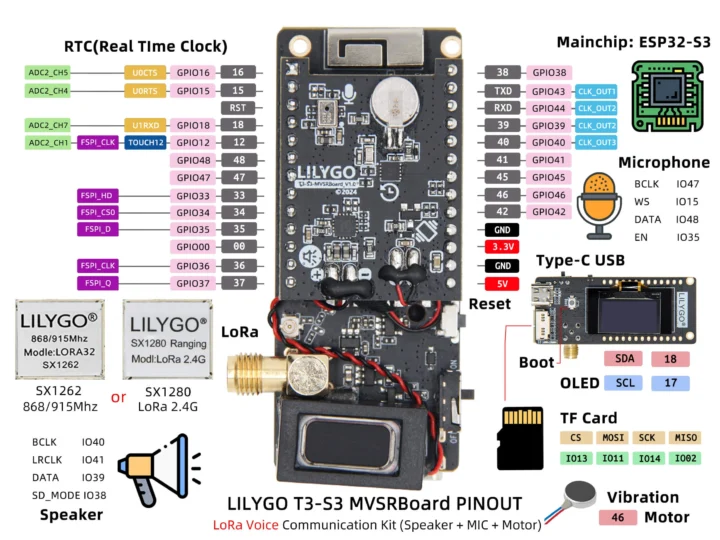With its low-power, long-range capabilities, LoRa has been used for P2P and Mesh messaging with firmware like MeshTastic, but due to its limited bandwidth, we haven’t seen quite as many LoRa audio applications.
This has not stopped LILYGO from designing the T3-S3 MVSR LoRa voice communication kit, integrating LoRa radio, a microphone, and a speaker to use the board as a walkie-talkie solution working over Semtech SX1262 or SX1280 RF transceiver.
LILYGO T3-S3 MVSR specifications:
- SoC – Espressif Systems ESP32-S3FH4R2
- CPU – Dual-core Tensilica LX7 microcontroller @ up to 240 MHz
- Wireless – 2.4 GHz 802.11n WiFi 4 and Bluetooth 5.0 LE connectivity
- Memory – 2MB PSRAM
- Storage – 4MB SPI flash
- Storage – MicroSD card slot
- Display – 0.96-inch 128×64 OLED display with SSD1306 I2C driver
- Audio
- MAX98357A Speaker
- MSM261S4030HOR Microphone
- LoRa module (one or the other)
- LORA32 SX1262 with 868MHz or 915 MHz radio
- LoRa 2.4G module based on Semtech SX1280 with 2.4GHz radio
- USB – 1x USB Type-C port for power and programming
- Misc
- Reset and Boot Buttons
- Vibration Motor
- RTC with backup battery
- Power Supply
- 5V/500mA charging via USB-C port
- 3.7V Lipo battery support
- Dimensions – 66 x 15 x 27mm

It’s not the first time the company adds a microphone and speaker to an ESP32+LoRa device, as the T-Deck Plus Blackberry-like devkit already had those. However, there are no LoRa audio code samples for it, even today, only I2S and microphone Arduino sketches. However, when I check out the GitHub repository for the T3-S3 MVSR LoRa Voice communication kit, the SX126x_Walkie_Talkie.ino sketch emulates the behavior of a Walkie-Talkie using Codec2 low-bitrate speech audio codec at 3200 bps, 8kHz 16-bit audio input, and transmission is done using FSK modulation at 914.6 MHz. All those parameters can be adjusted for regulatory compliance and tradeoffs between range and audio quality.
We should expect more LoRa/fast long-range communication (FLRC) audio applications in the future, especially once Semtech LR2021 LoRa Plus transceiver becomes more broadly available, since it’s specifically touted as a solution suitable for audio and image transmission thanks to a bandwidth of up to 2.6 Mbps with FLRC, 200 Kbps with LoRa. We have some other Arduino-programmable Walkie-Talkie solutions in the past, but they did not rely on a LoRa radio for audio. Those include LILYGO T-TWR REV2.1 ESP32 walkie-talkie and MessengerPi LoRa messenger and walkie-talkie based on Raspberry Pi RP2040.
 LILYGO sells the T3-S3 MVRS LoRa voice communication kit for $26.74 online. I assume it will also be sold on AliExpress and Amazon soon since the company has stored there. You’ll obviously need to get at least two kits to have any fun…
LILYGO sells the T3-S3 MVRS LoRa voice communication kit for $26.74 online. I assume it will also be sold on AliExpress and Amazon soon since the company has stored there. You’ll obviously need to get at least two kits to have any fun…

Jean-Luc started CNX Software in 2010 as a part-time endeavor, before quitting his job as a software engineering manager, and starting to write daily news, and reviews full time later in 2011.
Support CNX Software! Donate via cryptocurrencies, become a Patron on Patreon, or purchase goods on Amazon or Aliexpress






Cool.
Wikipedia: Physical range330 kilometres (210 mi) in perfect conditions. Approximately 10 kilometres (6.2 mi) in practical conditions
So this walkie-talkie should reach 10 km?
It’s probably shorter than that even for line-of-sight communication because audio requires a higher bitrate than messages, and the further away the two systems are, the lower the bitrate.
What is the maximum distance the product can be reached?
1336km
https://www.thethingsnetwork.org/article/new-lora-world-record-1336-km-830-mi
What works with small data packets won’t work with audio…
And even if it did, technically speaking it would be highly illegal, since LoRa is subject to 1% duty cycle limit, which makes it unusable for any kind of audio streaming if you want to stay within the rules.
Isn’t this using a point to point connection? The duty cycle limit is for LoRaWAN
Impossible to answer. You have to calculate the RF physics on your place on your own.
So lets give the other number becuase that could be answered: at minimum one meter
You write: “but due to its limited bandwidth, we haven’t seen quite as many LoRa audio applications.”
But Meshtastic have voice functionality build in and thus its widely spread.
> Meshtastic have voice functionality build in and thus its widely spread.
I just didn’t know that. I thought Meshtastic was just for messaging and GPS sharing.
I see that the T3-S3 MVSR uses the same hardware as needed for Meshtastic experimental audio support:
So just installing Meshtastic might work then, but an SX1280 radio is preferred. Sadly, it’s not the once sold on the LILYGO website right now.
You can do anything with it. For example connect from far away over lora to your HA-smart home, transmit sensor data and a ton of other use cases are already build in.
It’s worth noting that in some regions at least, duty cycle limits and/or dwell times will probably make this unusable.
Is it clear which transceiver is connected to the antenna?
You could in theory use some parabolic directional antenna to up the gain/range. For 2.4Ghz there will be many Wifi derived options
Only as permitted by the local regulations for the relevant band, of course. Which in many regions means “nope”…
900MHz is ISM band and it’s pretty open in most parts of the world.
Lyra google speech code has a perfect quality with only 3kbps. But it needs at least a smartphone to run, it can’t be implemented in low spec hardware. It would be the perfect speech codec for LoRa.